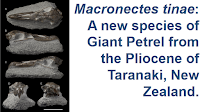Shearwaters, Procellariidae, are a diverse group of Tube-nosed Seabirds, Procellariiforms, with a fossil record going back to at least the Miocene (some Oligocene fossils have been assigned to the group - but the status of these is uncertain). All living and fossil Shearwaters are placed within three genera, the relatively large Calonectris, weighing 470–1060 g; the somewhat smaller Ardenna, weighing 320–950 g; and the notably smaller Puffinus, weighing 120–575 g (confusingly, Puffins are not Shearwaters at all, but members of the Auk family, Alcidae, with the generic name Fratercula). Shearwaters have a fairly good fossil record in the Northern Hemisphere, but until 2018 the known remains from the Southern Hemisphere comprised a few fragmentary bones from Mio-Pliocene assemblages in Chile, Peru, and South Africa. This changed with the discovery of Ardenna davealleni, a large gliding Shearwater from the Pliocene Taranaki Seabird Assemblage.
In a paper published in the journal Taxonomy on 6 April 2024, Alan Tennyson of the Museum of New Zealand Te Papa Tongarewa, Rodrigo Salvador of the Arctic University Museum of Norway, Barbara Tomotani of the Department of Arctic and Marine Biology at the Arctic University of Norway, and Felix Marx, also of the Museum of New Zealand Te Papa Tongarewa, describe a second Pliocene Shearwater from the Taranaki Assemblage.
The new species is described from two specimens. The first of these, NMNZ S.49931, is a partial articulated skeleton, comprising a complete skull and premaxilla, posterior right mandible, sternum, furcula, right coracoid, a row of articulated thoracic vertebrae, four ribs, both humeri, right ulna, right radius, and several small unidentified fragments, which was collected from Ohawe Beach, southern Taranaki, by Karl Raubenheimer. The second specimen, NMNZ S.49666, is another partial skeleton, comprising a complete skull and premaxilla, left quadrate, right coracoid, both humeri (missing their distal ends), right ulna, probable right radius, one vertebra, and several small unidentified fragments, collected by John Buchanan-Brown at Waihi Beach, South Taranaki. The species is placed in the genus Ardenna, and given the specific name buchananbrowni, in honour of John Buchanan-Brown.
Ardenna buchananbrowni is a small Shearwater, falling within the upper part of the size range of the genus Puffinus, and its general shape falls within the range of both Puffinus and diving members of the genus Ardenna. However, it is closest in form to Ardenna tenuirostris, the living Short-tailed Shearwater or Muttonbird, leading Tennyson et al. to conclude that it was a small diving member of the genus Ardenna.
The genera Ardenna and Puffinus are calculated to have diverged about 10.4 million years ago, based upon molecular clock data, with members of the genus Puffinus becoming specialised in diving, and some members of the genus Ardenna also later becoming specialist divers, and converging in form with Puffinus. The Taranaki Seabird Assemblage has been dated to between 3.36 and 3.06 million years before the present, making Ardenna buchananbrowni the oldest known diving Ardenna as well as the smallest, and demonstrating that members of the genus had adapted to a diving lifestyle in the Southern Ocean more than 3 million years ago.
See also...










